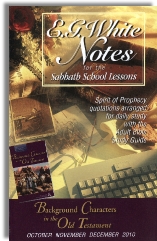|
||||||||||||||
Commentary on "Uriah: Faith of a Foreigner"
Day 2: Sunday, October 31, 2010 - The Slippery Slope
Overview
Entitled “Slippery Slope”, today’s lesson does not fail to carry out it’s declared purpose: to show the “slippery slope character” of sin’s consequences. This goal is accomplished by showing how David’s sin with Bathseba led from one heinous sin to another, starting with the murder of Uriah and ending with the revolt of David’s own son Absalom being consummated in Absalom’s death. While David has supremeo power to give commands, he fails to control his sin, and sin is reigning.
Observations
The focus on the consequences of David’s sin proves to eclipse the bigger picture of this story. The authors miss entirely the contrast between what’s happening on earth as a consequence of David’s adultery with Uriah’s wife and the divine perspective disclosed by the Bible in David’s repentance. The truly amazing thing in the story is that, despite the fact that David’s sin led to Uriah’s death, David’s repentance, captured in Psalm 51, gives us a glimpse into the real dimension of his sin. Instead of mourning the death of Uriah, the seriousness of his own plight, and the dishonor brought to Uriah’s wife, David is crying, “Against you, you only, have I sinned and done what is evil in your sight” (Psalm 51:4). Obviously David is not ignorant of his murder of Uriah and we can see in retrospect that more than the death of one man is going to be imputed to David. His own son conceived in adultery is going to die; he will have his wives defiled by another son, Absalom, ending with the pain of seeing Absalom being killed in the revolt. Despite all of these things, the true dimension of David’s sin is seen in the fact that his sin was first a foremost a sin against God.
David’s repentance is prompted by the message brought by the prophet Nathan. Using an illustration taken from David’s previous life as a shepherd, Nathan pictures a sharp contrast between David’s plight and Uriah’s. While David had many wives, Uriah had one. While David shared the throne, Uriah was a subordinate. Still David is so ungrateful toward God for the blessings he received from God’s hand that he steals his neighbor’s wife and continues on the path by taking his life also in order to cover his wicked deed. When Nathan brings the message, when Nathan makes David aware of the way in which David despised God (2 Samuel 12:1-10), David repents of his sins—not because of the bad consequences his sin had on others, not even because he became a murderer, but because in His mercy God allows him to see that his sin is much more heinous than mere “bad consequences”. David’s repentance follows God’s message of grace, and in the light of God’s mercies, David repents.
The model established for repentance seen in David’s repentance is the only correct way in which repentance functions. In the light of God’s mercies, our obedience is the expression of our gratitude for what God so graciously gave us. Repentance, as obedience, is based on gratitude for what God already did for us, for the blessings we already possess. The current lesson errs greatly in affirming that “repentance gains God’s mercy.” This summary statement is the equivalent of righteousness by works. Repentance doesn’t gain anything, repentance is the soul’s reaction when it understands God’s grace in contrast with one’s own lack of gratitude. Repentance is an expression of the soul’s turning from despising God’s blessings to truly appreciating God’s grace, in the past, as it well in the present.
Repentance cannot be done if, because of sin, believers are forfeiting God’s grace toward them. Even if there is just one sin, the believer needs to repent in order to get back his justified status. In these conditions, repentance is nothing more than works righteousness couched under the language of grace.
In reality, however, justification is a one time event; there is no longer any condemnation for those who are in Jesus Christ (Romans 8:1, John 5:34, Hebrews 10:14). And because we are justified, because we died to sin, because we have been raised to Christ (Romans 6), we repent of our sins and live a life of gratitude for what God already done for us anticipating also the heritage that will be ours in the future.
Copyright 2010 BibleStudiesForAdventists.com. All rights reserved. Revised October 29, 2010. This website is published by Life Assurance Ministries, Glendale, Arizona, USA, the publisher of Proclamation! Magazine. Contact email: BibleStudiesForAdventists@gmail.com.
The Sabbath School Bible Study Guide and the corresponding E.G. White Notes are published by Pacific Press Publishing Association, which is owned and operated by the Seventh-day Adventist church. The current quarter's editions are pictured above.
Official Adventist Resources
Standard Edition Study Guide Week 6
Teacher's Edition Study Guide Week 6
Easy Reading Edition Study Guide Wk 6
Search the Complete Published Ellen G. White Writings


